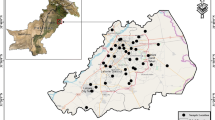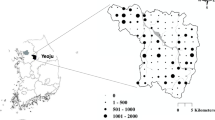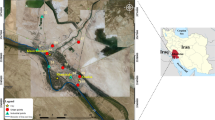Abstract
Plastic pollution is a now global problem that affects terrestrial, marine, and freshwater ecosystems. Small plastic particles (< 5 mm) are considered as microplastics (MPs) which can originate from primary and secondary sources. Microplastic pollution in terrestrial ecosystems is crucial since their abundance and flow are expected to be higher than aquatic systems. This research investigates the abundance and evaluation of current microplastic abundance in human-influenced soils to reveal the impact of different anthropogenic activities on soil MP contamination. Three main categories as industrial, residential, and recreational areas were considered, and samples from different land-uses for each category were collected in Istanbul, Turkey, and examined. Results showed that residential areas had the lowest MP content (mean = 3378 items/kg), while the highest abundance was found in recreational zones (mean = 7956 items/kg). The abundance of MPs in industrial areas was between these groups with a mean value of 4488 items/kg. The lowest concentration was observed in one of the residential zones with 1868 items/kg, and surprisingly, the highest content was found in a forestal recreational area (Belgrad forest) with 9332 items/kg. Shape ratios of particles were different for each category. Round/spherical particles had the highest share in industrial and residential areas with 34% and 32%, respectively, and fibers in recreational areas by 36%.






Similar content being viewed by others
Data Availability
The datasets generated during and/or analyzed during the current study are available from the corresponding author on reasonable request.
References
Almond, J., Sugumaar, P., Wenzel, M., Hill, G., & Wallis, C. (2020) Determination of the carbonyl index of polyethylene and polypropylene using specified area under band methodology with ATR-FTIR spectroscopy. e-Polymers, 20(1), 369–381. https://doi.org/10.1515/epoly-2020-0041
Amorim, M. J .B., & Fordsman, J. S. (2021). Plastic pollution – A case study with Enchytraeus crypticus – From micro-to nanoplastics. Envir Poll 271. https://doi.org/10.1016/j.envpol.2020.116363
Bolgar M., Hubball J., Groeger J., & Meronek S., (2008). Handbook for the Chemical Analysis of Plastic and Polymer Additives CRC Press, - 498. https://doi.org/10.1201/9781420044881
Chen, Y., Leng, Y., Liu, X., & Wang, J. (2020). Microplastic pollution in vegetable farmlands of suburb Wuhan, central China. Environmental Pollution. https://doi.org/10.1016/j.envpol.2019.113449
Choi, Y. R., Kim, Y. N., Yoon, J. H., Dickinson, N., & Kim, K. H. (2020). Plastic contamination of forest, urban, and agricultural soils: A case study of Yeoju City in the Republic of Korea. Journal of Soils and Sediments. https://doi.org/10.1007/s11368-020-02759-0
Cole, M., Lindeque, P., Halsband, C., & Galloway, T. S. (2011). Microplastics as contaminants in the marine environment: A review. Marine Pollution Bulletin. https://doi.org/10.1016/j.marpolbul.2011.09.025
Corradini, F., Meza, P., Eguiluz, R., Casado, F., Huerta-Lwanga, E., & Geissen, V. (2019). Evidence of microplastic accumulation in agricultural soils from sewage sludge disposal. Science of the Total Environment, 671, 411–414.
de Souza Machado, A. A., Kloas, W., Zarfl, C., Hempel, S., & Rillig, M. C. (2018). Microplastics as an emerging threat to terrestrial ecosystems. Global Change Biology. https://doi.org/10.1111/gcb.14020
de Souza Machado, A. A., Lau, C. W., Till, J., Kloas, W., Lehmann, A., Becker, R., & Rillig, M. C. (2018). Impacts of microplastics on the soil biophysical environment. Environmental Science and Technology, 52, 9656–9665. https://doi.org/10.1021/acs.est.8b02212
de Souza Machado, A. A., Lau, C. W., Till, J., Kloas, W., Bergmann, J., Bachelier, J. B., Faltin, E., Becker, R., Görlich, A. S., & Rillig, M. C. (2019). Microplastics can change soil properties and affect plant performance. Environmental Science and Technology, 53(10), 6044–6052. https://doi.org/10.1021/acs.est.9b01339
Ding, L., Zhang, S., Wang, X., Yang, X., Zhang, C., Qi, Y., & Guo, X. (2020). The occurrence and distribution characteristics of microplastics in the agricultural soils of Shaanxi Province, in north-western China. Science of the Total Environment. https://doi.org/10.1016/j.scitotenv.2020.137525
Dris, R., Gasperi, J., Rocher, V., Saad, M., Renault, N., & Tassin, B. (2015). Microplastic contamination in an urban area: A case study in greater Paris. Environmental Chemistry. https://doi.org/10.1071/EN14167
Fakour, H., Lo, S.-L., Yoashi, N. T., Massao, A. M., Lema, N. N., Mkhontfo, F. B., Jomalema, P. C., Jumanne, N. S., Mbuya, B. H., Mtweve, J. T., & Imani, M. (2021). Quantification and analysis of microplastics in farmland soils: Characterization, sources, and pathways. Agriculture. https://doi.org/10.3390/agriculture11040330
Fuller, S. G., & Gautam, A. (2016). A procedure for measuring microplastics using pressurized fluid extraction. Environmental Science & Technology. https://doi.org/10.1021/acs.est.6b00816
Haward, M., (2020). Science-based solutions to plastic pollution. One Earth 2 (1), 5–7 ISSN, 2590–3322. https://doi.org/10.1016/j.oneear.2020.01.004.
Hildebrant, L., Nack, F.L., Zimmerman, T., & Pröfock, D. (2021). Microplastics as a Trojan horse for trace metals, JHM Letters 2- 100035. https://doi.org/10.1016/j.hazl.2021.100035
Horton, A. A., Svendsen, C., Williams, R. J., Spurgeon, D. J., & Lahive, E. (2017). Large microplastic particles in sediments of tributaries of the River Thames, UK – Abundance, sources and methods for effective quantification. Marine Pollution Bulletin. https://doi.org/10.1016/j.marpolbul.2016.09.004
Huerta Lwanga, E., Gertsen, H., Gooren, H., Peters, P., Salánki, T., Van Der Ploeg, M., Besseling, E., Koelmans, A.A., & Geissen, V. (2016). Microplastics in the terrestrial ecosystem: Implications for Lumbricus terrestris (Oligochaeta, Lumbricidae). Environ Sci Technol. https://doi.org/10.1021/acs.est.5b05478
Hurley, R. R., Lusher, A. L., Olsen, M., & Nizzetto, L. (2018). Validation of a method for extracting microplastics from complex, organic-rich, environmental matrices. Environmental Science and Technology. https://doi.org/10.1021/acs.est.8b01517
Jansen, J., (2015). Plastic Failure Through Molecular Degradation, Plastics Engineering, Available at: http://read.nxtbook.com/wiley/plasticsengineering/january2015/consultantscorner.html. Accessed 20 Oct 2022
Jiang, X. J., Liu, W., Wang, E., Zhou, T., & Xin, P. (2017). Residual plastic mulch fragments effects on soil physical properties and water flow behavior in the Minqin Oasis, northwestern China. Soil Tillage Res. https://doi.org/10.1016/j.still.2016.10.011
Kim, S.W., Waldman, W.R., Kim, T., & Rillig, M.C. (2020). Effects of different microplastics on nematodes in the soil environment: Tracking the extractable additives using an ecotoxicological approach. Environ Sci Technol. 54 (21), https://doi.org/10.1021/acs.est.0c04641
Klein, S., Worch, E., & Knepper, T. P. (2015). Occurrence and spatial distribution of microplastics in river shore sediments of the rhine-main area in Germany. Environmental Science and Technology. https://doi.org/10.1021/acs.est.5b00492
Li, L., Zhou, Q., Yin, N., Tu, C., & Luo, Y. (2019). Uptake and accumulation of microplastics in an edible plant. Kexue Tongbao/Chinese Sci Bull. https://doi.org/10.1360/N972018-00845
Li, L., Luo, Y., Li, R., Zhou, Q., Peijnenburg, W.J.G.M., Yin, N., Yang, J., Tu, C., & Zhang, Y. (2020a). Effective uptake of submicrometre plastics by crop plants via a crack-entry mode. Nat Sustain. https://doi.org/10.1038/s41893-020-0567-9
Li, R., Li, L., Zhang, Y., Yang, J., Tu, C., Zhou, Q., Li, Y., & Luo, Y. (2020b). Uptake and accumulation of microplastics in a cereal plant wheat. Kexue Tongbao/Chinese Sci Bull. https://doi.org/10.1360/TB-2020-0030
Mehdinia, A., Dehbandi, R., Hamzehpour, A., & Rahnama, R. (2020). Identification of microplastics in the sediments of southern coasts of the Caspian Sea, north of Iran. Environmental Pollution. https://doi.org/10.1016/j.envpol.2019.113738
Munno, K., Helm, P. A., Jackson, D. A., Rochman, C., & Sims, A. (2018). Impacts of temperature and selected chemical digestion methods on microplastic particles. Environmental Toxicology and Chemistry. https://doi.org/10.1002/etc.3935
Nizzetto, L., Bussi, G., Futter, M. N., Butterfield, D., & Whitehead, P. G. (2016). A theoretical assessment of microplastic transport in river catchments and their retention by soils and river sediments. Environmental Science. Processes & Impacts, 18, 1050–1059. https://doi.org/10.1039/C6EM00206D
Pagès, P. (2015). Characterization of polymer materials using FT-IR and DSC techniques, Thermal Analysis. Fundamentals and Applications to Material Characterization, 2005: 121–140. ISBN: 84–9749–100–9.
Piehl, S., Leibner, A., Löder, M.G.J., Dris, R., Bogner, C., & Laforsch, C. (2018). Identification and quantification of macro- and microplastics on an agricultural farmland. Sci Rep. https://doi.org/10.1038/s41598-018-36172-y
Pignattelli, S., Broccoli, A., & Renzi, M. (2020). Physiological responses of garden cress (L sativum) to different types of microplastics. Sci Total Environ, 727, 138609. https://doi.org/10.1016/j.scitotenv.2020.138609
Qi, R., Jones, D. L., Li, Z., Liu, Q., & Yan, C. (2020). Behavior of microplastics and plastic film residues in the soil environment: A critical review. Science of the Total Environment. https://doi.org/10.1016/j.scitotenv.2019.134722
R Core Team. (2019). R: A language and environment for statistical computing. R Foundation for Statistical Computing, Vienna, Austria.
Rafique, A., Irfan, M., Mumtaz, M., & Qadir, A. (2020). Spatial distribution of microplastics in soil with context to human activities: A case study from the urban center. Environmental Monitoring and Assessment, 192(11), 671. https://doi.org/10.1007/s10661-020-08641-3
Rillig, M. C. (2012). Microplastic in terrestrial ecosystems and the soil? Environmental Science & Technology, 46, 6453–6454. https://doi.org/10.1021/es302011r
Scheurer, M., & Bigalke, M. (2018). Microplastics in Swiss floodplain soils. Environmental Science and Technology. https://doi.org/10.1021/acs.est.7b06003
Selonen, S., Dolar, A., Kokalj, A. J., Skalar, T., Dolcet, L. P., Hurley, R., & van Gestel, C. A. M. (2020). Exploring the impacts of plastics in soil – The effects of polyester textile fibers on soil invertebrates. Science of the Total Environment, 700, 134451. https://doi.org/10.1016/j.scitotenv.2019.134451
Thompson, R. C., Olsen, Y., Mitchell, R. P., Davis, A., Rowland, S. J., John, A. W., McGonigle, D., & Russell, A. E. (2004). Lost at sea: Where is all the plastic? Science, 304, 838. https://doi.org/10.1126/science.1094559
Tunali, M., Uzeofuna, E. N., Tunali, M. M., & Yenigun, O. (2020). Effect of microplastics and microplastic-metal combinations on growth and chlorophyll a concentration of Chlorella vulgaris. Science of the Total Environment, 743, 140479. https://doi.org/10.1016/j.scitotenv.2020.140479
Wang, J., Li, J., Liu, S., Li, H., Chen, X., Peng, C., Zhang, P., & Liu, X. (2021). Distinct microplastic distributions in soils of different land-use types: A case study of Chinese farmlands. Environmental Pollution. https://doi.org/10.1016/j.envpol.2020.116199
Wang, F., Zhang, X, Zhang, S, Zhang, S, & Sun, Y. (2020). Interactions of microplastics and cadmium on plant growth and arbuscular mycorrhizal fungal communities in an agricultural soil. Chem 254.https://doi.org/10.1016/j.chemosphere.2020.126791
Yang, X., Bento, C. P. M., Chen, H., Zhang, H., Xue, S., Lwanga, E. H., Zomer, P., Ritsema, C. J., & Geissen, V. (2018). Influence of microplastic addition on glyphosate decay and soil microbial activities in Chinese loess soil. Environmental Pollution. https://doi.org/10.1016/j.envpol.2018.07.006
Zbyszewski, M., & Corcoran, P. L. (2011). Distribution and degradation of fresh water plastic particles along the beaches of Lake Huron, Canada. Water Air Soil Pollut. https://doi.org/10.1007/s11270-011-0760-6
Zeng, L.S., Zhou, Z.F., & Shi, Y. X. (2013). Environmental problems and control ways of plastic film in agricultural production. Applied Mechanics and Materials. https://doi.org/10.4028/www.scientific.net/AMM.295-298.2187. Accessed 18 August 2022
Zhang, G. S., & Liu, Y. F. (2018). The distribution of microplastics in soil aggregate fractions in southwestern China. Science of the Total Environment, 642, 12–20. https://doi.org/10.1016/j.scitotenv.2018.06.004
Zhang, L., Xie, Y., Liu, J., Zhong, S., Qian, Y., & Gao, P. (2020). An overlooked entry pathway of microplastics into agricultural soils from application of sludge-based fertilizers. Environmental Science and Technology. https://doi.org/10.1021/acs.est.9b07905
Zhang, J., Wu, X., Guo, H., Zheng, X., & Mai, B. (2021). Pollution of plastic debris and halogenated flame retardants (HFRs) in soil from an abandoned e-waste recycling site: Do plastics contribute to (HFRs) in soil?. Journal of Hazardous Materials. 124649–. https://doi.org/10.1016/j.jhazmat.2020.124649
Zhou, Y., Liu, X., & Wang, J. (2019). Characterization of microplastics and the association of heavy metals with microplastics in suburban soil of central China. Science of The Total Environment. 694, 133798–. https://doi.org/10.1016/j.scitotenv.2019.133798
Acknowledgements
This study was partially supported by Bogazici Research Fund, Project No: 17383P. The authors thank Boğaziçi University, Department of Molecular Biology and Genetics, specifically Efe Elbeyli for his contribution towards microscopic evaluation. Acknowledgements also go to Ankara University, Nuclear Sciences Institute, Electron Microscope Laboratory, and Dr. Elif Yildiz for SEM imaging and analysis.
Author information
Authors and Affiliations
Contributions
Mehmet Meric Tunali: Conceptualization, Investigation, Analysis, Methodology, Writing–Original draft.
Oleksiy Myronyuk: FTIR analysis/interpretation, Writing–review and editing.
Merve Tunali: Conceptualization, Methodology, Analysis, Writing–review and editing.
Orhan Yenigun: Conceptualization, Project administration, Funding acquisition, Supervision, Writing–review and editing.
Corresponding author
Ethics declarations
Conflict of Interest
The authors declare no competing interests.
Additional information
Publisher's Note
Springer Nature remains neutral with regard to jurisdictional claims in published maps and institutional affiliations.
Supplementary Information
Below is the link to the electronic supplementary material.
Rights and permissions
Springer Nature or its licensor (e.g. a society or other partner) holds exclusive rights to this article under a publishing agreement with the author(s) or other rightsholder(s); author self-archiving of the accepted manuscript version of this article is solely governed by the terms of such publishing agreement and applicable law.
About this article
Cite this article
Tunali, M.M., Myronyuk, O., Tunali, M. et al. Microplastic Abundance in Human-Influenced Soils in Recreational, Residential, and Industrial Areas. Water Air Soil Pollut 233, 433 (2022). https://doi.org/10.1007/s11270-022-05901-5
Received:
Accepted:
Published:
DOI: https://doi.org/10.1007/s11270-022-05901-5




